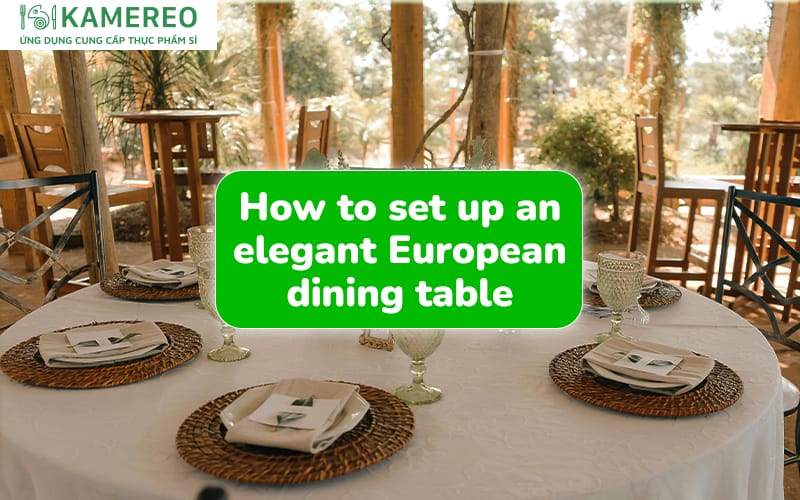The art of setting up a European is not just about arranging utensils; it’s also a display of a restaurant’s class and meticulous attention to detail. From the position of each plate and knife to the arrangement of glasses and cups, every detail contributes to creating an elegant and professional dining space. To better understand how to create a perfect European dining table, refer to this article by Kamereo for more useful and detailed information!
Essential Utensils for European Table Settings
To create an exquisite and refined European dining table, a restaurant needs to prepare a full range of utensils suitable for each dish and beverage. The items used are not only diverse but also need to be arranged according to standard European etiquette:
- Plates: Charger plate, appetizer plate, soup plate, bread plate.
- Condiments: Salt and pepper shakers.
- Knives: Dinner knife, fish knife, appetizer knife, butter knife.
- Spoons: Soup spoon, dessert spoon.
- Forks: Dinner fork, fish fork, main course fork, appetizer fork, dessert fork.
- Glasses: Water glass, red wine glass, white wine glass, spirits glass, champagne flute.
- Napkins: Neatly folded cloth napkin, suitable for the space.
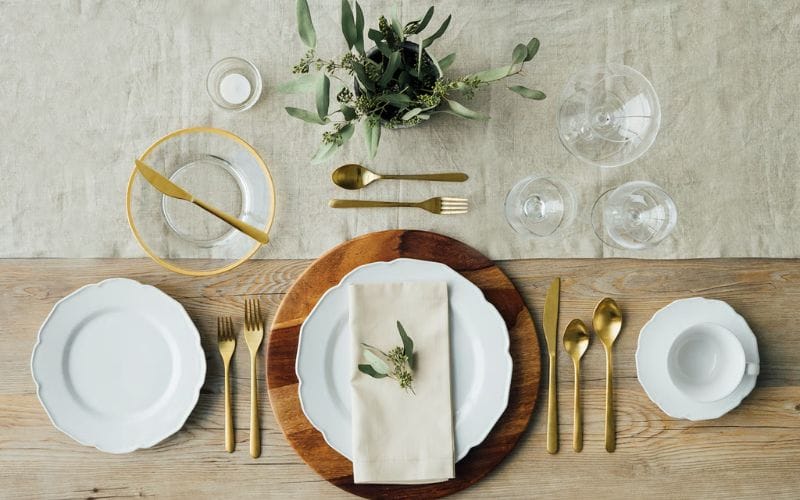
Rules for Setting a European Dining Table
Depending on the nature and purpose of each meal, the European table setting will be adjusted accordingly. However, there are fundamental principles that all European restaurants must master and strictly apply:
Placing the Charger Plate
The charger plate serves as the foundation for arranging other utensils. It is placed in the center of the seat, about 2cm from the edge of the table, to create balance and ease for the guest.

Placing the Utensils
Utensils are arranged in a logical sequence, making it easy for guests to use them from the first course to the last. The general rule is to arrange them from the inside out, from right to left, and then upwards:
- The dinner knife is placed to the right of the charger plate, 1cm away, and 2cm from the table edge. The blade of the knife always faces the plate.
- The fish knife is placed 1cm from the dinner knife, with its handle 2cm from the table edge.
- The soup spoon is placed 1cm from the fish knife, with its handle 2cm from the table edge.
- The dessert fork is placed 2cm above the charger plate.
- The dessert spoon is placed above and parallel to the dessert fork, 1cm apart.
- The dinner fork is placed to the left of the charger plate, 1cm away, and 2cm from the table edge.
- The fish fork is placed next to the dinner fork, 1cm away, with its handle 2cm from the table edge.
- The bread and butter plate is placed next to the dinner fork, 1cm apart, so that ⅓ of the plate is above the fork’s top and ⅔ is below the fork’s top.
- The butter knife is placed parallel to the fork, with its handle level with the fork’s top, making it convenient for spreading butter.
Placing the Glasses
The water glass is the first glass to be placed, positioned above the dinner knife, 2cm away. The remaining glasses (red wine glass, white wine glass, spirits glass, champagne flute) are placed at a 45-degree angle to the water glass, with each glass 1cm apart to create harmony and convenience during use.
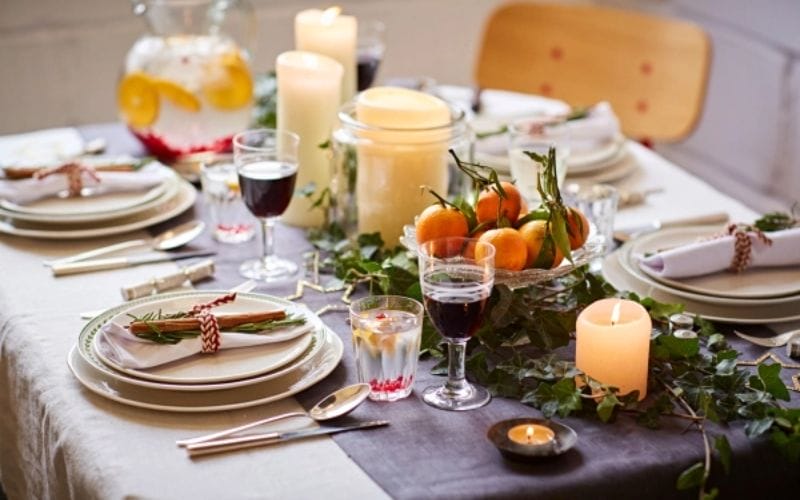
Placing Centerpiece Items
Centerpiece items contribute to completing the dining table setting and serving the general needs of guests:
- Oil and vinegar cruets are placed at the right end of the table for the guest, 2cm from the table edge.
- A flower vase is an indispensable highlight, placed in the center of the table to enhance aesthetic appeal.
- Salt and pepper shakers are placed to the right of the host, 2cm from the table edge, with salt on the right, pepper on the left, and the labels facing inwards, demonstrating meticulous attention to even the smallest details.
Placing the Napkin
Napkins are neatly and beautifully folded and placed on the charger plate, both convenient for guests and enhancing the elegance of the table.
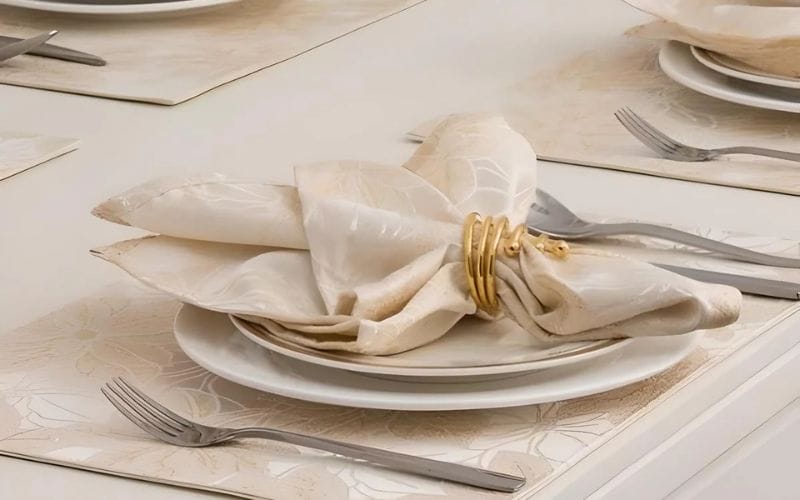
Adjusting Utensils
After placing all the utensils, a final check and adjustment are necessary to ensure perfection. The distance between utensils must adhere to the rules: 2cm vertically, 1cm horizontally, creating a balanced and professional overall look.
Different European Table Setting Styles
Each meal, with its different purpose and time, will have a distinct European table setting style, reflecting the restaurant’s sophistication and thoughtfulness. Here are some popular setting styles that restaurants can adopt:
Breakfast Table
Breakfast is usually simple but still requires full amenities. Essential utensils include:
- Large knife and fork for the main course.
- Bread plate and butter knife.
- Neatly folded napkin.
- Cup and saucer for coffee or tea.
- Teapot or coffee pot.
- Basic condiments like salt, pepper, sugar.
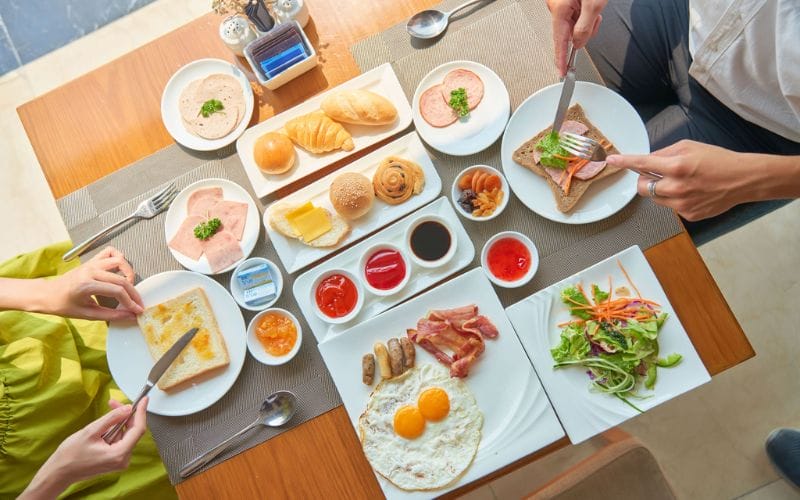
Lunch Table
Lunch can be more flexible, suitable for light meals or business lunches:
- Salad plate and main course plate.
- Dinner knife.
- Dinner spoon, soup spoon, and dessert spoon.
- Empty plate (underplate).
- Water glass.
- Tea or coffee cup.
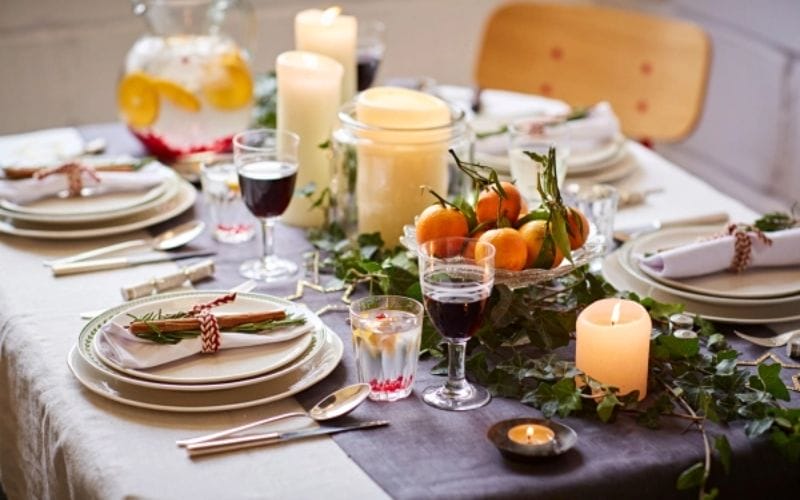
Formal Lunch Table
When lunch is more formal (a reception), the setup will be more elaborate:
- Salad plate and empty plate (underplate).
- Main course knife and butter knife.
- Dinner spoon, soup spoon, and dessert spoon.
- Main course plate.
- Bread and butter plate.
- Water glass and wine glass.
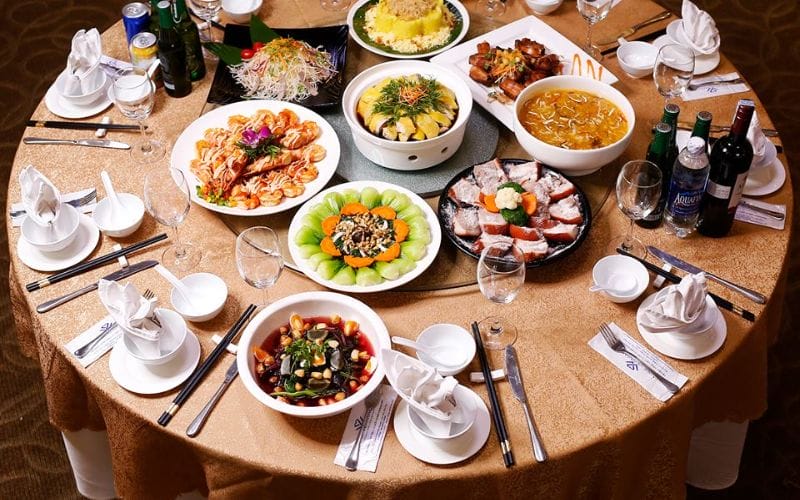
Dinner Table
Dinner tables are usually set more formally, focusing on a premium dining experience:
- Dinner plate (charger plate).
- Main course knife.
- Dinner spoon and dessert spoon.
- Dessert plate.
- Underplate (main course plate).
- Water glass and wine glass.
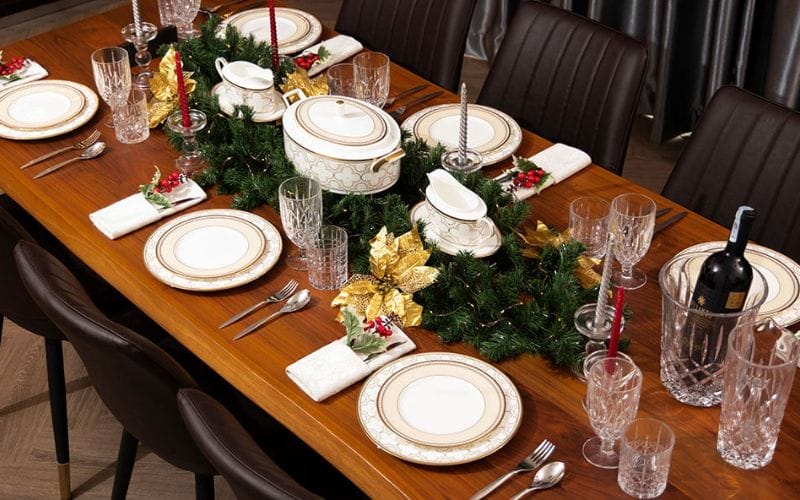
Formal Dinner Table
This is the most complex setting, reserved for special events or luxurious parties:
- Salad plate and dinner plate (charger plate).
- Dinner knife and butter knife.
- Dinner spoon.
- Bread plate.
- Main course plate.
- Various types of glasses: water glass, champagne flute, white wine glass, red wine glass.

How to Place Knives, Spoons, and Plates on a European Table
The way knives, spoons, and plates are placed on a European table reflects sophistication in every detail. The arrangement must follow certain rules to ensure aesthetic appeal and convenience during the meal:
When Starting
When beginning to set a European dining table, the arrangement of knives, spoons, and plates must adhere to certain principles, helping guests easily identify and use them correctly:
- To the right of the main dinner plate, you will place the dinner knife with its blade facing the plate. Next is the dinner spoon, and outermost is the soup spoon.
- Conversely, to the left of the main dinner plate is the position for various forks, arranged from inside out: dinner fork, salad fork, dessert fork, and finally a seafood fork (if applicable).
- The bread plate is placed to the upper left of the main dinner plate, with a butter knife neatly placed on the plate.
- When guests begin their meal, they will sequentially pick up knives and forks according to the pre-set arrangement on the table, typically from the outside in, corresponding to the dishes being served.
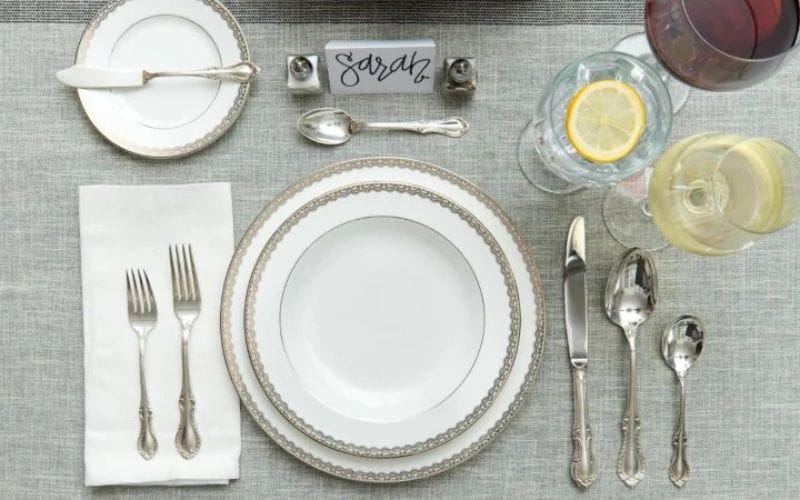
When Finished Eating
In European restaurants, after a meal, placing the cutlery in the correct position is an important signal to service staff about whether the guest has finished their dish or not. There are two common ways to place cutlery after eating, depending on the culture and habits of each region:
European style:
- When wanting to pause a meal, guests will place the knife and fork crossed on the plate, with the fork on top of the knife and the tines of the fork pointing downwards. This indicates that they will continue eating shortly.
- When the meal is completely finished, the knife and fork will be placed parallel to each other, aligned in the center of the plate. Both the knife blade and the fork tines point downwards, signaling that the dish has been enjoyed and can be cleared.
American style:
- When pausing a meal, the knife will be placed on the upper edge of the plate, at a 45-degree angle. The tines of the fork are placed pointing upwards on the plate.
- When the meal is complete, the knife and fork will be placed parallel on the plate, but this time the tines of the fork will point upwards. This is a sign that the guest has finished the dish and the plate can be cleared.
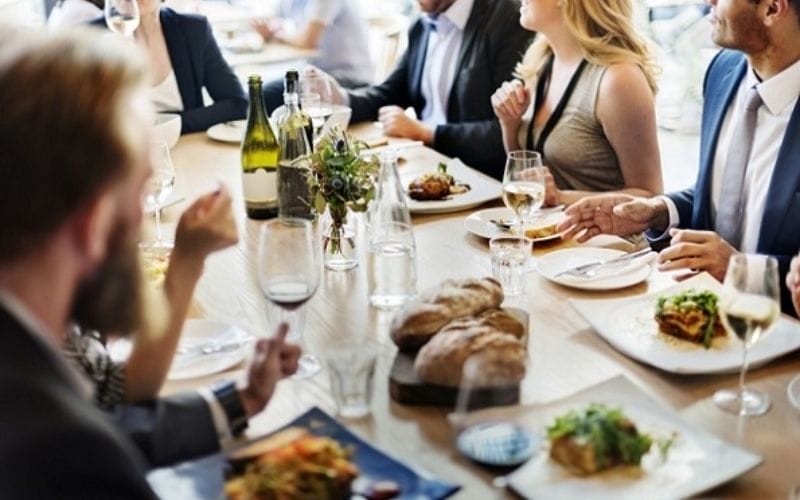
Kamereo – Professional Wholesale Food Supplier for Restaurants
Kamereo is a pioneering wholesale food supplier that leverages technology to simplify the food supply chain. We are always striving to provide modern, transparent, and efficient purchasing solutions for F&B businesses.
With over 3,000 diverse products from food to kitchen utensils, Kamereo helps customers order quickly on a single platform. Our fast delivery team allows orders to be placed until midnight and delivered before 6 AM the next day, with an on-time delivery rate exceeding 99%.
Product quality is strictly controlled through three layers from farm, to purchasing center, to distribution warehouse. Kamereo’s supply comes from VietGAP-certified farms, partnering with genuine brands to ensure maximum stability and food safety.
Additionally, Kamereo provides a smart management application that supports businesses in controlling multiple branches, approving orders, tracking costs, and analyzing purchasing data. Transparent pricing policies, periodic quotes, and automatic electronic invoices help businesses easily control budgets and comply with legal requirements.
With professional operational processes, on-site support services, and flexible return policies, Kamereo is not just a supplier but also a strategic partner, helping restaurants grow sustainably and optimize business efficiency in the competitive F&B industry.

Conclusion
Thus, setting up a European dining table is an art that requires meticulous attention to detail, from selecting utensils and arranging them, to adhering to standard etiquette. We hope that through this article, you will gain more knowledge to elevate the dining space in your restaurant. Don’t forget to explore Kamereo’s Business Tips section for more useful information!
See more:



